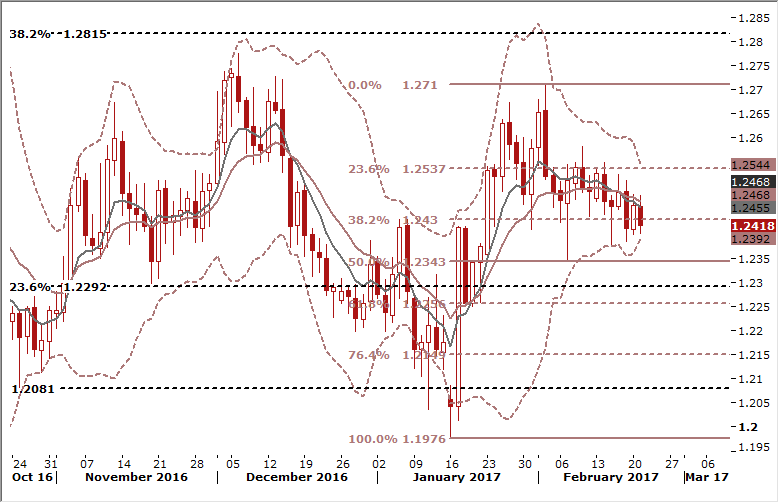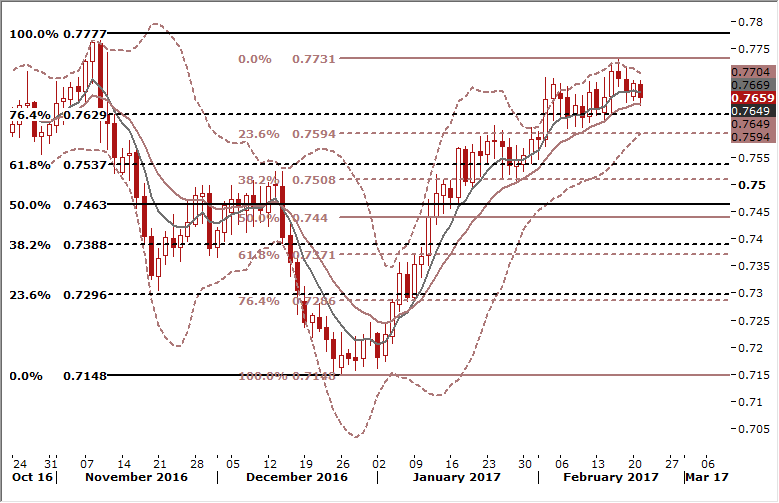EUR/USD: Eurozone economy seen running at near 6-year high
Macroeconomic overview
Cleveland Federal Reserve President Loretta Mester said on Monday she would be comfortable raising interest rates at this point if the economy maintained its current pace of performance. Mester, seen as one of the more hawkish Fed officials, said the economy was on a "sound footing". She also cautioned against asking the central bank to solve problems beyond its control, such as low productivity growth. Mester has dissented against decisions to keep rates steady at past meetings, instead preferring a faster pace of rate hikes.
Philadelphia Federal Reserve President Patrick Harker (a voting member) repeated his view that a March rise was on the table.
Mester and Harker are hawkish FOMC members, but in our opinion the voting majority does not share their view on rate hike in March. In our opinion 2017 roster of voting members is more dovish than it was in 2016. Key hawks - Kansas City Fed President Esther George and Cleveland Fed President Loretta Mester - were rotated off the FOMC. New members Charles Evans, Robert Kaplan and Neel Kashkari called for patience on hike. Patrick Harker is the only hawk among new FOMC voting members.
The Fed is in its tightening cycle, so we think that Harker will be probably voting for rate hikes at every meeting now. That is why the market will learn to ignore his opinions over time and will focus mainly on comments from FOMC centrists.
Minutes of the January 31-February 1 meeting, out Wednesday, could signal if another Fed hike is imminent. We think that it is unlikely that the minutes will point to a hike in March, as there was not such a signal in the statement after the recent FOMC meeting.
Tuesday brought us superb data from the Eurozone. Eurozone flash composite PMI, seen as a good overall growth indicator, rose sharply to 56.0, the highest since April 2011, from 54.4 in January, confounding expectations for a slight dip to 54.3. The broad-based acceleration, which showed France's momentum getting close to Germany's, suggests that if sustained, economic growth could hit 0.6% in the first quarter. That is faster than current market forecast of 0.4%.
The renewed strength in the PMIs would also come as a welcome relief to the European Central Bank, widely expected to remain on the sidelines in the coming meetings. The EUR/USD dropped strongly in the morning of the European session. A strong batch of purchasing manager surveys out of Eurozone countries were not enough to halt the falls in the EUR. Given strong Eurozone data and nothing new from hawkish FOMC members, we cannot find a fundamental explanation for today’s strong move in the EUR/USD. That is why there is a risk of recovery if tomorrow’s FOMC minutes disappoint.
Technical analysis
The nearest support level is 1.0522 low on February 15. Breaking below this level will open the way to 1.0451 (76.4% fibo of January-February rise) and then to a full retracement to the January 1.0340 base. We see a risk for this bearish scenario if tomorrow’s minutes are disappointing for USD bulls. 
Trading strategy
The February 15 rejection of a downward move looks to be false. Our long position is under water and the support at 1.0522 is a last resort now.
GBP/USD: No big moves after Carney’s speech
Macroeconomic overview
Bank of England Governor Mark Carney was challenged by lawmakers on Tuesday over the central bank's decision to alter a fundamental assumption that helps it to justify keeping interest rates at a record low.
The BoE said earlier this month it believed Britain's unemployment rate could fall to 4.5% - down from a previous estimate of 5% - before it starts to push up inflation. That could help the central bank to keep rates low for longer, despite the resilience of Britain's economy so far to the decision by voters last year to leave the European Union. Britain's unemployment rate currently stands at 4.8%.
Andrew Tyrie, the head of a panel of lawmakers who monitor the BoE, pressed Carney to explain the change during a regular question-and-answer session in parliament. Tyrie said,
This matters a lot because the Bank of England can allow forecast growth to rise without inflationary consequences once you've lowered this number. And indeed that seems to be a crucial ingredient for your making of assumptions on whether to raise interest rates.
Carney said the decision to lower the so-called equilibrium unemployment rate estimate was the result of an annual review and that some members of the Bank's Monetary Policy Committee had felt for years that it was too high. One MPC member, Ian McCafferty, told the lawmakers that he believed the rate stood at 4.75%, slightly higher than the consensus view of the nine-member committee. Earlier this month, fellow rate setter Kristin Forbes also said she believed the rate was not as low at 4.5%, and that there could soon be a case to raise interest rates.
Market interest rates rose earlier this year as Britain's economy continued to grow strongly after the Brexit vote shock and speculation mounted that the BoE might raise rates.
The BoE dampened down that speculation this month when signalled it was in no hurry to raise rates, in part due to its view on the lower equilibrium interest rate.
Sterling fell against the broadly stronger USD but made ground versus the EUR. Carney’s appearance does not have a strong influence on the GBP today. Revised fourth-quarter GDP figures are due on Wednesday.
Technical analysis
Technical analysis does not provide clear signal for this pair. Rally attempts are stemmed by the declining 10-dma (currently at 1.2480). Friday’s drop threatened the cloud but there was no clear break. The pair is supported by 100-dma at 1.2407. 
Trading strategy
We stay long for 1.2700. A close above 7-day exponential moving average (currently at 1.2455) would boost GBP/USD bulls’ confidence. Less hawkish FOMC minutes tomorrow may help.
AUD/USD needs more fuel to close above 0.7700
Macroeconomic overview
Minutes of its February meeting showed the Reserve Bank of Australia was in an optimistic mood when it kept rates at a record low of 1.5% for a seventh straight month, following easings in August and May last year.
Economic growth was expected to pick up to 3% by year-end and a shock contraction in the third quarter was only due to “temporary factors”. According to the minutes,
The economy was continuing its transition following the end of the mining investment boom. Australia’s low cost producers of iron ore were expected to increase output further and ramp up in liquefied natural gas production was expected to make a significant contribution to output growth. The drag on growth from falling mining investment was also expected to diminish.
The RBA had slashed its near-term forecast for economic growth by a whole percentage point following the third-quarter contraction, but is confident of a rebound over the next two years. Core inflation, currently pinned at a record low of 1.5%, is expected to pick up only gradually to around 1.75% by mid-2017 and might not fully return to the RBA's 2-3% target band until the middle of 2019.
Board members again noted that prices for Australia's key commodity exports had risen sharply in past months, which blessed the country with its largest trade surplus on record in December. Governor Philip Lowe has repeatedly argued that cutting rates further could encourage a renewed borrowing binge by households who are already heavily indebted, outweighing any economic benefits.
Technical analysis
The AUD/USD remains above the 14-day exponential moving average, but the pace of the AUD appreciation has lowered. The AUD/USD needs more fuel to close above the 0.7700. Tomorrow’s FOMC minutes may support this pair, if they are less hawkish than expected. 
Trading strategy
Our short-term AUD/USD long is risk free now, as we raised the stop-loss to the entry point.
